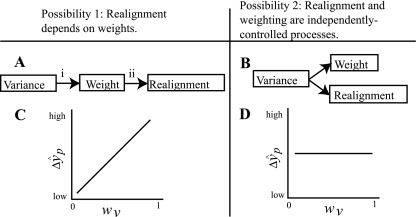Fig. 2.
Views of the relationship between sensory weights and realignment. A: possibility 1. The sensory modality with greater variance will be weighted less in an integrated sensory estimate (i) and will realign more if realignment takes place (ii). The connection between variance and weights (i) has been demonstrated in a number of human behaviors (e.g., Ghahramani et al. 1997; van Beers et al. 1999; Ernst and Banks 2002), but the relationship between sensory realignment and weights (ii) has been studied only indirectly (van Beers et al. 2002). B: possibility 2. In the present study, we found evidence to support an alternative view, in which weighting and realignment are two independently controlled processes, either of which can be used to compensate for a sensory misalignment. It should be noted that while weights (Ghahramani et al. 1997; van Beers et al. 1999; Ernst and Banks 2002) and realignment (Ghahramani et al. 1997; van Beers et al. 2002; Burge et al. 2008) have each been linked to the relative variances in sensory estimates, we do not suggest that either weights or realignment are wholly dependent on variance; other influences, such as attention/conscious effort, have been shown to affect both weights (Warren and Schmitt 1978) and realignment (Kelso et al. 1975). Accuracy may also be important (Di Luca et al. 2009). C and D: experimental predictions. C: if possibility 1 is correct and sensory realignment depends on weights, we predicted that in both experiments, subjects with a higher weight of vision (wV) would show a greater realignment of proprioception (ΔŷP). D: if possibility 2 is correct and sensory realignment is controlled independently of weights, we expected wv and ΔŷP to be unrelated in at least one of the two experiments.

